Here’s a quick guide to cutting and scoring balloons you can use during PCI.
Scoring balloons come in different designs — some with metal blades on the balloon surface, others with nylon scoring elements or Nitinol wires that wrap around the balloon for controlled lesion modification.
One of the key benefits is the lower risk of major vessel dissection, making it more likely that the procedure can be completed with a DCB (drug-coated balloon) rather than stent implantation.
In the past, crossing performance was a major concern, and these devices were used only in carefully selected cases.
However, today’s devices have significantly improved in deliverability, and they are now being used in a wider range of clinical situations.
Unlike standard balloons, scoring balloons have blades or scoring elements attached, so careful attention is needed when selecting the balloon diameter.
- Mechanism of Scoring Balloon Expansion
- Product Overview
- Specifications of All Scoring Balloon Products
- KIZASHI – Product Specifications (by Kaneka Medix)
- WOLVERINE – Product Specifications (by Boston Scientific)
- Aperta NSE – Product Specifications (by Nipro)
- ScoreFlex2 & ScoreFlex NC – Product Specifications (by OrbusNeich)
- ScoreFlex TRIO – Product Specifications (by OrbusNeich)
- AngioSculpt Evo – Product Specifications (by Philips)
- Summary
Mechanism of Scoring Balloon Expansion
Expansion Images of All Types of Scoring Balloons
These are the expansion images for different types of scoring balloons.
Only the ScoreFlex series from OrbusNeich Medical is shown with a 0.014″ guidewire, which is used for PCI.
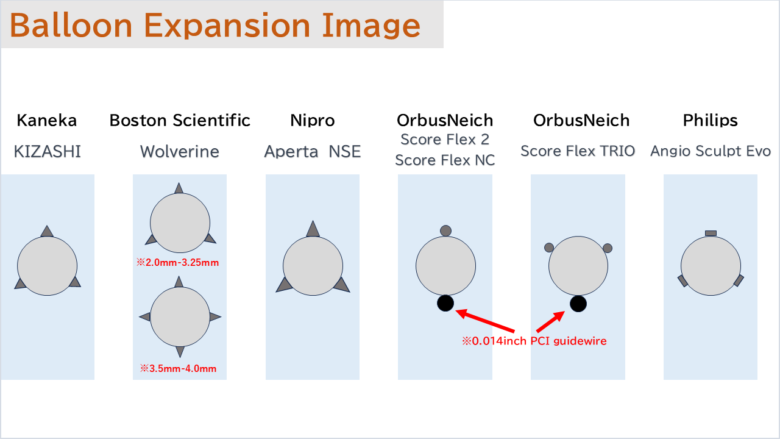
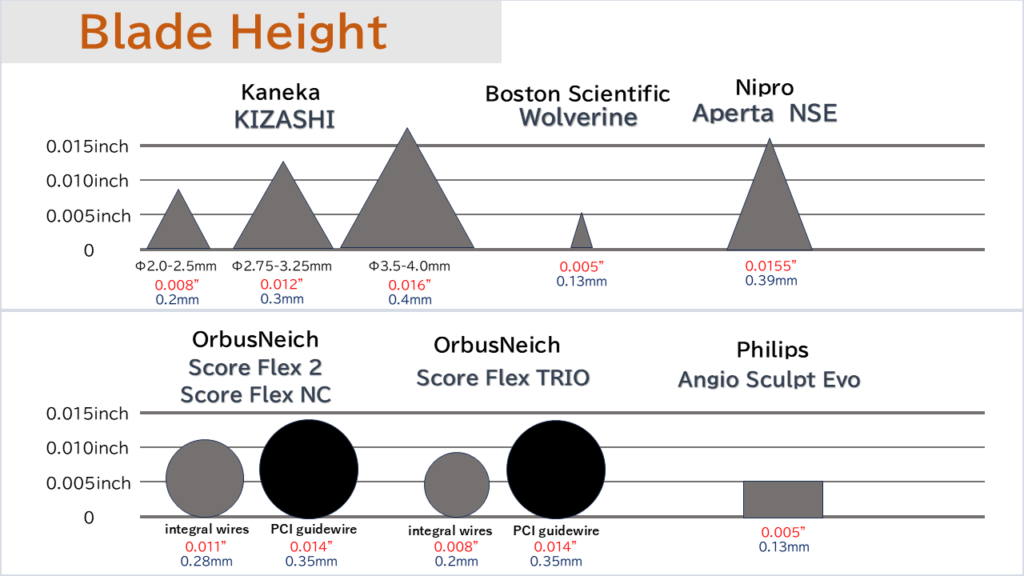
The height of the blades or scoring elements tends to be higher in KIZASHI and NSE, which use nylon-based elements.
This is likely because nylon is less aggressive in penetrating lesions compared to metal, so the elements are designed taller to achieve deeper scoring.
On the other hand, Boston Scientific’s Wolverine uses razor-like metal blades, which are known for their strong lesion penetration.
Even though the blades are lower in height, the design allows for effective scoring due to the sharpness and aggressiveness of the metal.
How Scoring Balloons Expand Lesions
During inflation, the majority of the force in a scoring balloon is concentrated on the blades or scoring elements.
These components are designed to firmly engage with the lesion, assisting in effective plaque modification and vessel expansion.
When the blades or elements anchor well into the lesion, tensile force is also distributed between them, allowing for additional expansion in the areas between the scoring components.
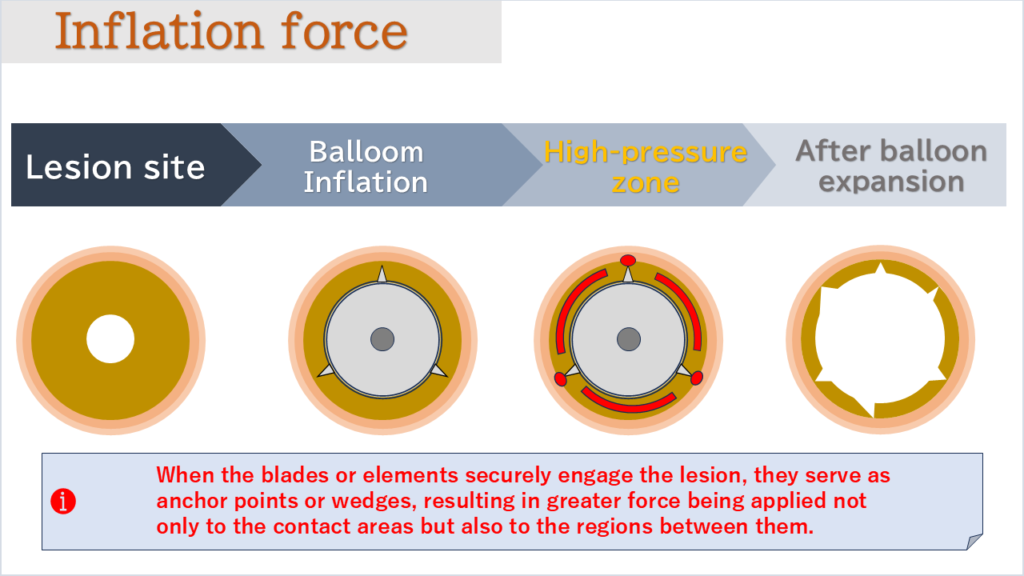
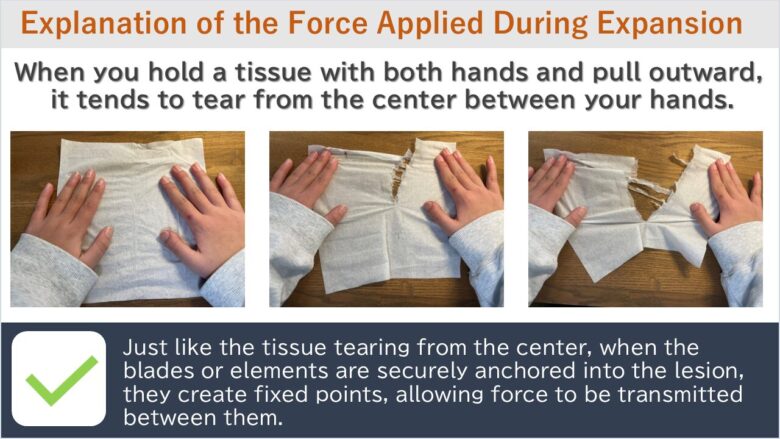
If you firmly hold both ends of a tissue and pull outward, the tissue will tear from the center between your hands.
This is similar to how a scoring balloon works during inflation.
When the blades or scoring elements are securely embedded in the lesion and the balloon is anchored in place, force is not only applied to the elements themselves—tension is also transmitted between them, allowing expansion to occur even in the spaces between the scoring points.
Product Overview
Specifications of All Scoring Balloon Products
Each product’s features are shown through both charts and visuals.
We will now explain the following seven types of scoring balloons in detail:
- Kaneka – KIZASHI
- Boston Scientific – Wolverine
- Nipro – Aperta NSE
- OrbusNeich – ScoreFlex2
- OrbusNeich – ScoreFlex NC
- OrbusNeich – ScoreFlex TRIO
- Philips – AngioSculpt Evo
KIZASHI – Product Specifications (by Kaneka Medix)
Product Details
Its lesion crossability is surprisingly high for a scoring balloon, and the balloon material is so resistant to stretching that it could be called a “super non-compliant” balloon.
Another unique feature is that the blade height varies depending on the balloon diameter, which allows for safer use even in small-caliber vessels.
On the other hand, the aggressiveness of the blades may raise some concern regarding lesion penetration.
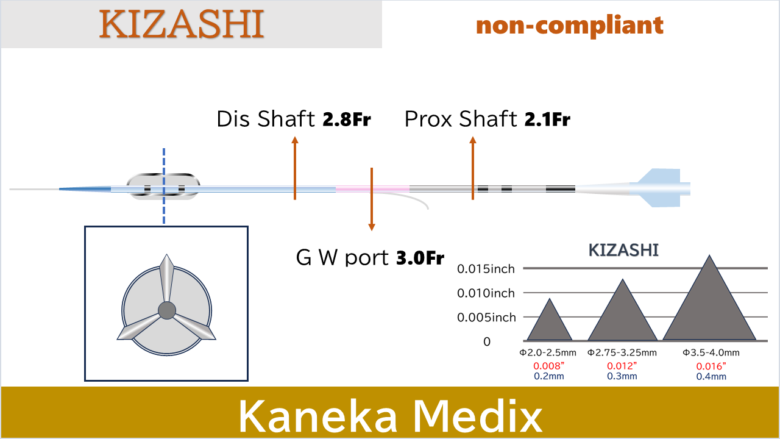
| Manufacturer | Kaneka Medix |
| Product Name | KIZASHI |
| Category | Cutting Balloon |
| Balloon Type | Non-compliant |
| Nominal Pressure (NOM) | 20 atm |
| Rated Burst Pressure (RBP) | 24 atm |
| Blade Material | Nylon |
| Number of Blades/Elements | 3 |
| Blade Height | 0.2 mm (0.008 inch) for balloon diameters of 2.0–2.5 mm 0.3 mm (0.012 inch) for balloon diameters of 2.75–3.25 mm 0.4 mm (0.016 inch) for balloon diameters of 3.5–4.0 mm |
Available Sizes
| 6mm | 9mm | 10mm | 13mm | 15mm | 20mm | |
| 1.75mm | ||||||
| 2.00mm | ● | ● | ||||
| 2.25mm | ● | ● | ||||
| 2.50mm | ● | ● | ||||
| 2.75mm | ● | ● | ||||
| 3.00mm | ● | ● | ||||
| 3.25mm | ● | |||||
| 3.50mm | ● | ● | ||||
| 3.75mm | ||||||
| 4.00mm |
WOLVERINE – Product Specifications (by Boston Scientific)
Product Details
One of Wolverine’s defining features is its razor-like metal blades, which concentrate pressure directly onto the lesion.
This makes it one of the most aggressive scoring balloons in terms of lesion penetration.
Despite the blade’s razor-like structure, its height is relatively low at 0.13 mm, minimizing the risk of damaging healthy vessel walls — allowing for safe use even in delicate areas.
One important point to note: the blades are positioned inside the balloon markers.
While most balloons are labeled by the outer marker-to-marker length, Wolverine’s specified balloon size refers to the area between the inner markers, and the blades are mounted even further inside.
This structural difference is a key distinction from other scoring balloons and should be carefully considered during sizing and deployment.
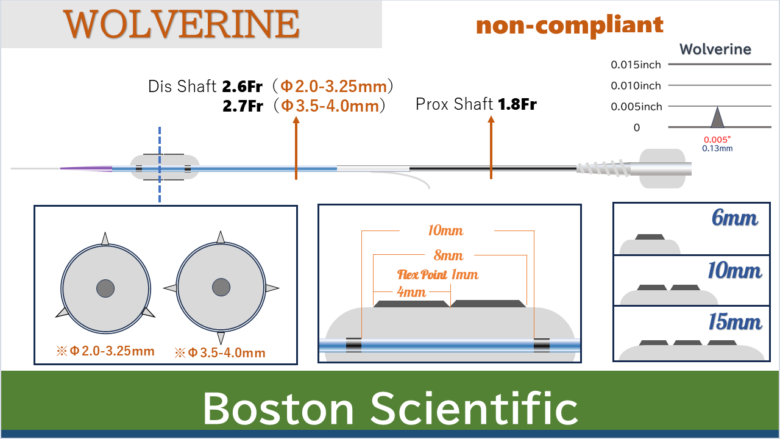
| Manufacturer | Boston Scientific |
| Product Name | WOLVERINE |
| Category | Cutting Balloon |
| Balloon Type | Non-compliant |
| Nominal Pressure (NOM) | 6 atm |
| Rated Burst Pressure (RBP) | 12 atm |
| Blade Material | Stainless Steel |
| Number of Blades/Elements | 3 blades for balloon sizes 2.0–3.25 mm 4 blades for balloon sizes 3.5–4.0 mm |
| Blade Height | 0.13 mm (0.005 inch) |
Available Sizes
| 6mm | 9mm | 10mm | 13mm | 15mm | 20mm | |
| 1.75mm | ||||||
| 2.00mm | ● | ● | ● | |||
| 2.25mm | ● | ● | ● | |||
| 2.50mm | ● | ● | ● | |||
| 2.75mm | ● | ● | ● | |||
| 3.00mm | ● | ● | ● | |||
| 3.25mm | ● | ● | ● | |||
| 3.50mm | ● | ● | ● | |||
| 3.75mm | ● | ● | ● | |||
| 4.00mm | ● | ● | ● |
Aperta NSE – Product Specifications (by Nipro)
Product Details
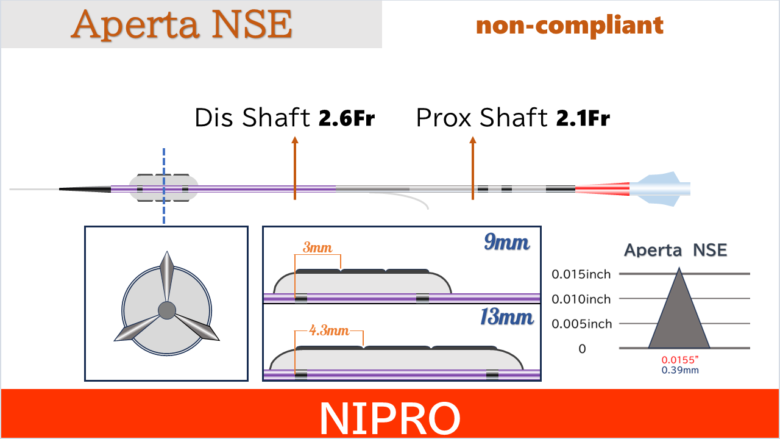
| Manufacturer | Nipro |
| Product Name | Aperta NSE |
| Category | Anti-slipping Type (Scoring Balloon) |
| Balloon Type | Non-compliant |
| Nominal Pressure (NOM) | 14 atm |
| Rated Burst Pressure (RBP) | 24 atm |
| Blade Material | Nylon |
| Number of Blades/Elements | 3 |
| Blade Height | 0.39 mm (0.0155 inch) |
Available Sizes
| 6mm | 9mm | 10mm | 13mm | 15mm | 20mm | |
| 1.75mm | ||||||
| 2.00mm | ● | ● | ||||
| 2.25mm | ● | ● | ||||
| 2.50mm | ● | ● | ||||
| 2.75mm | ● | ● | ||||
| 3.00mm | ● | ● | ||||
| 3.25mm | ● | ● | ||||
| 3.50mm | ● | ● | ||||
| 3.75mm | ||||||
| 4.00mm | ● | ● |
ScoreFlex2 & ScoreFlex NC – Product Specifications (by OrbusNeich)
Product Details

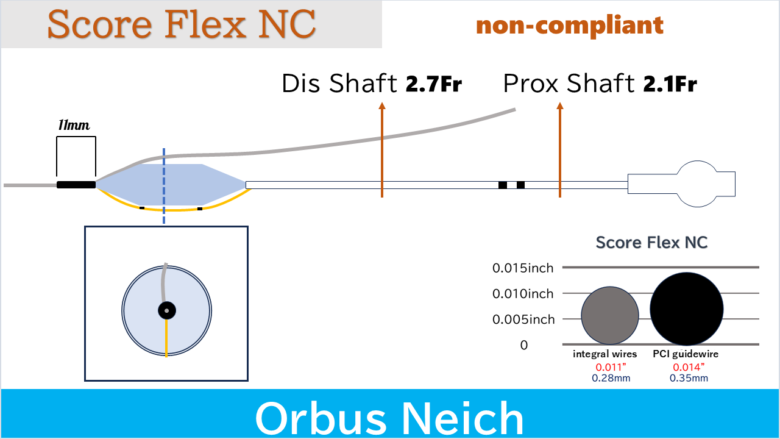
| Manufacturer | OrbusNeich | OrbusNeich |
| Product Name | ScoreFlex2 | ScoreFlex NC |
| Category | General PCI Balloon | General PCI Balloon |
| Balloon Type | Semi-compliant | Non-compliant |
| Nominal Pressure (NOM) | 6 atm | 12 atm |
| Rated Burst Pressure (RBP) | 14 atm | 20 atm |
| Blade Material | Nitinol | Nitinol |
| Number of Blades/Elements | 1 integral scoring wire + PCI guidewire | 1 integral scoring wire + PCI guidewire |
| Blade Height | 0.28 mm (0.011 inch) for integral wires + 0.35 mm (0.014 inch PCI guidewire) | 0.28 mm (0.011 inch)for integral wires + 0.35 mm (0.014 inch PCI guidewire) |
ScoreFlex TRIO – Product Specifications (by OrbusNeich)
Product Details
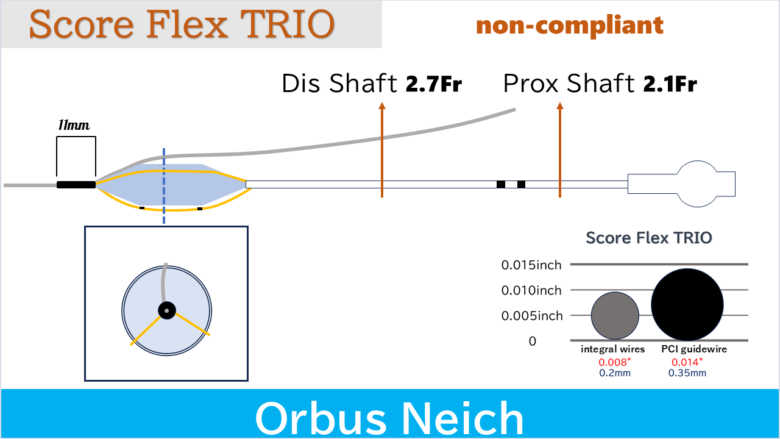
| Manufacturer | OrbusNeich |
| Product Name | ScoreFlex TRIO |
| Category | Anti-slipping Type (Scoring Balloon) |
| Balloon Type | Non-compliant |
| Nominal Pressure (NOM) | 12 atm |
| Rated Burst Pressure (RBP) | 20 atm |
| Blade Material | Nitinol |
| Number of Blades/Elements | 2 integral scoring wires + 1 PCI guidewire |
| Blade Height | 0.2 mm (0.008 inch) for integral wires + 0.35 mm (0.014 inch PCI guidewire) |
Available Sizes
| 6mm | 9mm | 10mm | 13mm | 15mm | 20mm | |
| 1.75mm | ● | ● | ● | |||
| 2.00mm | ● | ● | ● | |||
| 2.25mm | ● | ● | ● | |||
| 2.50mm | ● | ● | ● | |||
| 2.75mm | ● | ● | ● | |||
| 3.00mm | ● | ● | ● | |||
| 3.25mm | ● | ● | ● | |||
| 3.50mm | ● | ● | ● | |||
| 3.75mm | ||||||
| 4.00mm | ● | ● | ● |
AngioSculpt Evo – Product Specifications (by Philips)
Product Details

| Manufacturer | Philips |
| Product Name | AngioSculpt Evo |
| Category | Anti-slipping Type (Scoring Balloon) |
| Balloon Type | Semi-compliant |
| Nominal Pressure (NOM) | 8 atm for balloon sizes 2.0–3.0 mm 10 atm for balloon size 3.5 mm |
| Rated Burst Pressure (RBP) | 16 atm |
| Blade Material | Nitinol |
| Number of Blades/Elements | 3 |
| Blade Height | 0.13 mm (0.005 inch) |
Available Sizes
| 6mm | 9mm | 10mm | 13mm | 15mm | 20mm | |
| 1.75mm | ||||||
| 2.00mm | ● | ● | ● | ● | ||
| 2.25mm | ||||||
| 2.50mm | ● | ● | ● | ● | ||
| 2.75mm | ||||||
| 3.00mm | ● | ● | ● | ● | ||
| 3.25mm | ||||||
| 3.50mm | ● | ● | ● | ● | ||
| 3.75mm | ||||||
| 4.00mm |
Summary
Scoring balloons are highly effective devices in PCI, enabling precise force concentration and controlled lesion modification.
Each product has unique characteristics in terms of blade structure and expansion behavior, making appropriate device selection essential based on lesion morphology and treatment strategy.
The seven products introduced here are all designed with attention to anti-slipping performance, expansion capability, and safety, and each offers distinct advantages.
By comparing features such as penetration strength, balloon compliance, and blade material and height, you can choose the device best suited to the case.
A proper understanding and selection of scoring balloons will help achieve safer and more reliable interventional procedures.

☑️Category List






コメント